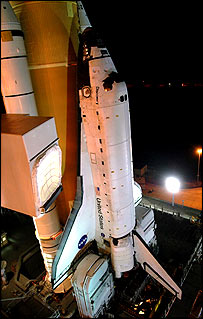NASA officials said that the shuttle is not yet ready for launch due to unresolved issues with the accumulation of ice on the external fuel tank

The American space agency (NASA) announced that the launch of the shuttle Discovery will not take place until July.
The delay of about two months is due to the decision of the agency managers that the fuel tank, which caused the Columbia disaster in February 2003, is not yet ready for flight.
NASA initially set May 15 as the target date for the launch, but since then it has been postponed twice. The ferry fleet has been grounded since the disaster.
The considerations for NASA's decision to postpone the launch to the next possible daytime launch window, in July, were the growing concerns about the accumulation of ice forming outside the outer container. The fear is that the ice will fall off when the shuttle takes off after the launch and damage delicate parts of the ship's heat shield.
Even though the space shuttles were showered with small particles of debris thousands of times during their 24 years of service, NASA could no longer innocently close its eyes to the possibility of danger.
As I recall, a piece of insulating material filled with ice fell from the external fuel tank during the launch of the Space Shuttle Columbia, causing a hole to form in a sensitive spot in the wing's reinforcement panel, through which hot air entered 16 days later when the shuttle entered the atmosphere for landing.
NASA redesigned the external fuel tank to replace the foam layer glued on these tanks with electric heaters, but the problem still remains.
Last week, the director of the shuttle program told reporters that engineers had found 170 locations of potential foam-falling hazards and addressed them all, but there were still dozens of threats to the shuttle's safety. A renewed examination at the Kennedy Space Center was done on Tuesday and Wednesday of the week, but the managers still could not reduce their concerns.
One of the concerns is the 21 meter long strip of explosives on the outer edge of the fuel tank. Before launch, the tank is filled with 1.9 million liters of liquid oxygen and liquid hydrogen, both of which need to be kept in a deep freeze despite the Florida sun and humidity. The fuel feeds the shuttle engines themselves during the launch. Engineers are concerned that frost and ice could build up near the top of the explosive tube and cause it to explode during launch, endangering the shuttle.
NASA may decide to add an electric heater to the suspect area before Discovery Flight is approved. The insulating foam layer around the line was designed on the one hand to prevent condensation of water and frost from turning into a block of ice. However, when the upgraded tank was filled with fuel during an experiment on the launch pad about weeks ago, the danger of a potential accumulation of ice still remained.
"We will not launch if we think there is still concern about an unacceptable amount of ice that could damage the spacecraft," Shuttle Program Deputy Director Wayne Hale told reporters last week.
